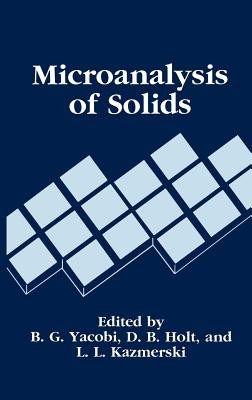
- We will send in 10–14 business days.
- Publisher: Springer
- ISBN-10: 030644433X
- ISBN-13: 9780306444333
- Format: 15.6 x 23.4 x 2.7 cm, hardcover
- Language: English
- SAVE -10% with code: EXTRA
Microanalysis of Solids (e-book) (used book) | bookbook.eu
Reviews
Description
The main objective of this book is to systematically describe the basic principles of the most widely used techniques for the analysis of physical, structural, and compositional properties of solids with a spatial resolution of approxi- mately 1 m or less. Many books and reviews on a wide variety of microanalysis techniques have appeared in recent years, and the purpose of this book is not to replace them. Rather, the motivation for combining the descriptions of various mi- croanalysis techniques in one comprehensive volume is the need for a reference source to help identify microanalysis techniques, and their capabilities, for obtaining particular information on solid-state materials. In principle, there are several possible ways to group the various micro- analysis techniques. They can be distinguished by the means of excitation, or the emitted species, or whether they are surface or bulk-sensitive techniques, or on the basis of the information obtained. We have chosen to group them according to the means of excitation. Thus, the major parts of the book are: Electron Beam Techniques, Ion Beam Techniques, Photon Beam Techniques, Acoustic Wave Excitation, and Tunneling of Electrons and Scanning Probe Microscopies. We hope that this book will be useful to students (final year undergrad- uates and graduates) and researchers, such as physicists, material scientists, electrical engineers, and chemists, working in a wide variety of fields in solid- state sciences.
EXTRA 10 % discount with code: EXTRA
The promotion ends in 16d.20:04:04
The discount code is valid when purchasing from 10 €. Discounts do not stack.
- Publisher: Springer
- ISBN-10: 030644433X
- ISBN-13: 9780306444333
- Format: 15.6 x 23.4 x 2.7 cm, hardcover
- Language: English English
The main objective of this book is to systematically describe the basic principles of the most widely used techniques for the analysis of physical, structural, and compositional properties of solids with a spatial resolution of approxi- mately 1 m or less. Many books and reviews on a wide variety of microanalysis techniques have appeared in recent years, and the purpose of this book is not to replace them. Rather, the motivation for combining the descriptions of various mi- croanalysis techniques in one comprehensive volume is the need for a reference source to help identify microanalysis techniques, and their capabilities, for obtaining particular information on solid-state materials. In principle, there are several possible ways to group the various micro- analysis techniques. They can be distinguished by the means of excitation, or the emitted species, or whether they are surface or bulk-sensitive techniques, or on the basis of the information obtained. We have chosen to group them according to the means of excitation. Thus, the major parts of the book are: Electron Beam Techniques, Ion Beam Techniques, Photon Beam Techniques, Acoustic Wave Excitation, and Tunneling of Electrons and Scanning Probe Microscopies. We hope that this book will be useful to students (final year undergrad- uates and graduates) and researchers, such as physicists, material scientists, electrical engineers, and chemists, working in a wide variety of fields in solid- state sciences.


Reviews